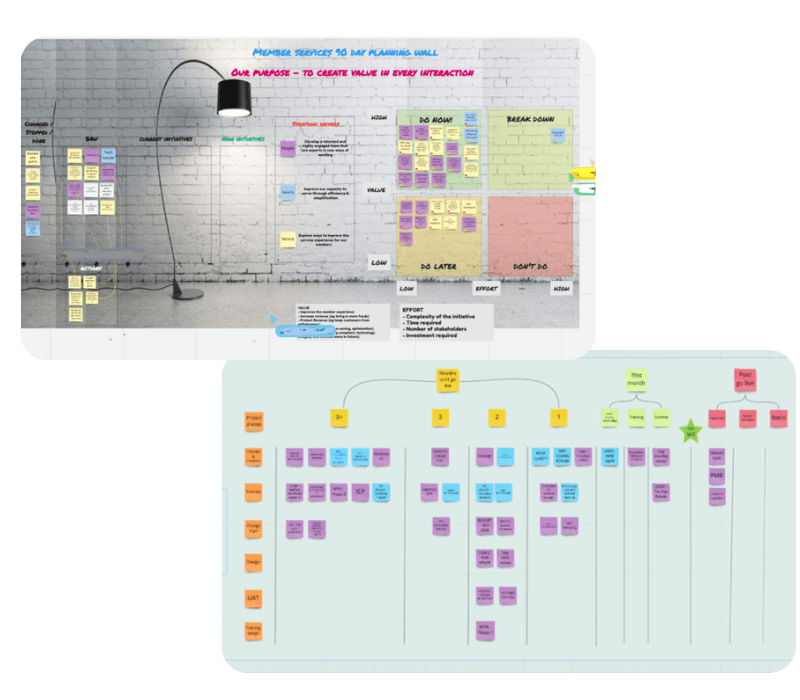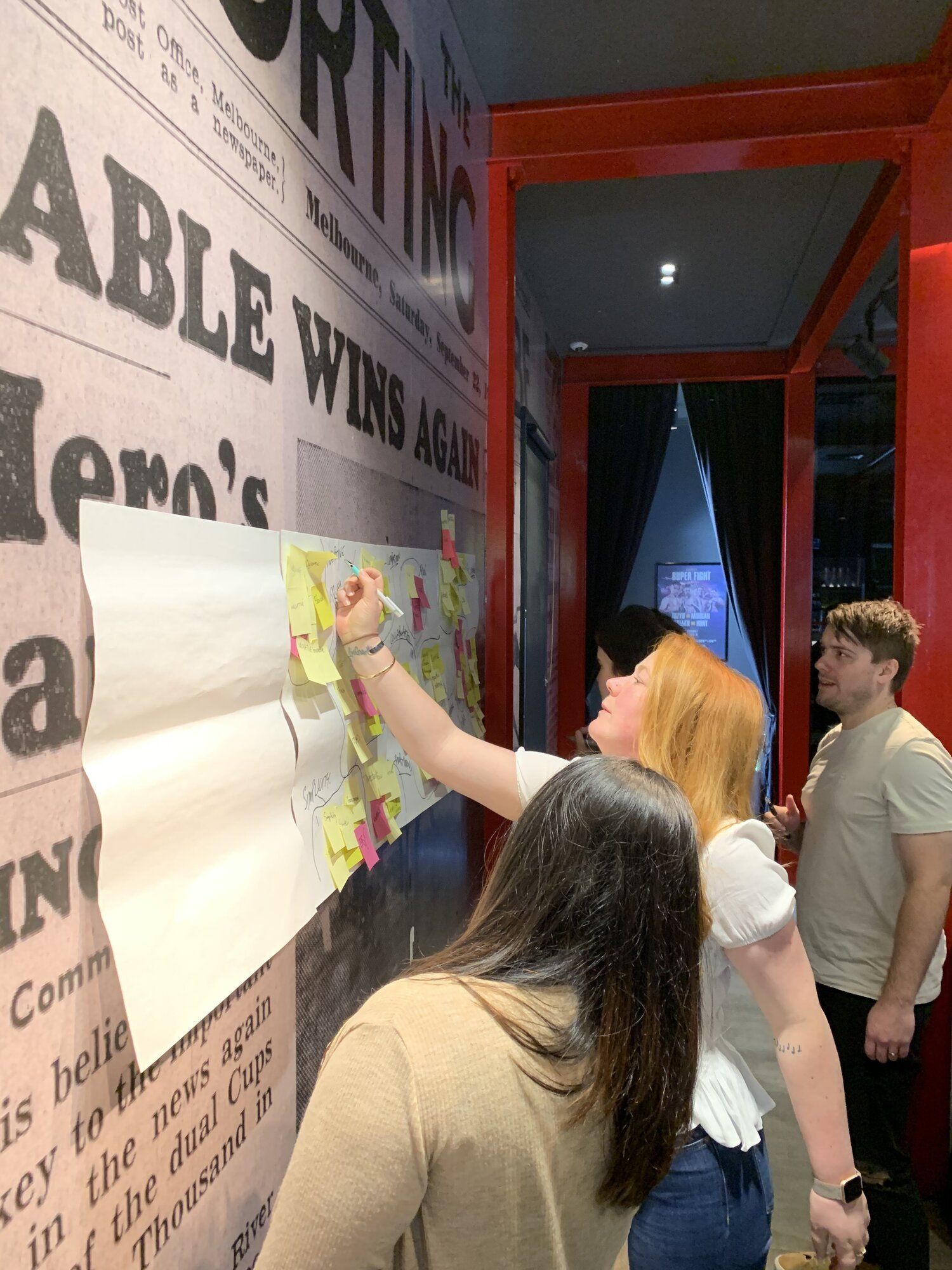CASE STUDIES
‘The self-organising team’
A daily stand-up to decide the days priorities and organise the work, a process is owned and run by team members. The whiteboard visualises the right metrics so they can see the customer experience and make decisions on how to improve it.
Their challenge
We worked with Philips Healthcare to transform their servicing model from product silos to a multi-skilled customer centric approach so they could anticipate customer needs. In order to do this, they needed to create the structure and capacity for their teams as well as uplift their capability to provide service across multiple products, this was a paradigm shift for everyone.

What they did
Through a collaborative process the leadership team got aligned on a new service vision and then started to work through the initiatives they needed to be complete to bring it to life. From here they set up a visualisation wall to deliver the work over the next 90-days, working in two-week cycles called ‘sprints’. This was all set up using online collaboration tools as the team was a combination of office based and remote (this was well before COVID).
A key part of this transformation was embedding the principles of self-organisation into the way their front-line teams worked so they could own the work and the decisions about how the work would be done. The teams set up an iterative process to visualise the right metrics and uncover any issues associated with the transformation, like call routing issues. Their daily rhythm meant they could review the results of their decisions and tweak their approach and it meant that leaders could jump on any issues quickly to get them escalated to the right area to be fixed.
What they achieved?
- The leadership team successfully delivered on the timelines and objectives for the transformation using the 90-Day planning process, with high levels of employee engagement.
They became a truly responsive team that didn’t rely on layers of hierarchy to make decisions each day about the best way to serve customers and meant a big mindset shift from the people and leaders to play different roles than they were used to. Because team members could see customer demand in real time it meant they could hold each other accountable for being available for customers improving the time it took to respond and first contact resolution.

How WE REMOVED Failure Demand At MLC
Outcome
MLC created an ongoing environment for removing failure demand in the contact centre. After 6 months, the team had removed over 500 calls a month by identifying some simple solutions, working with the technology and product teams.
Introducing Failure Demand
What if I told you that there’s a different way to look at call centres?
The traditional mindset is to think about call centres as a factory completing each call to take the next. And the job of the call centre manager is to ensure that the conditions are in place so that agents are taking calls in the shortest time possible ready to take the next call in the shortest time possible.
This often leads to outcomes of quick answer times but lower customer satisfaction and poorer employee experience.
What we propose is taking a systems thinking mindset towards the work, looking from the lens of calls that customers want to make (value demand) and don’t want to make (failure demand). The role of the call centre manager is to work with the organisation to remove failure demand. Thereby increasing customers satisfaction not just with the call centre but with the organisation and a far better employee experience.
Is this achievable? Yes it is.. read on about how we achieved this.
How They Did It (Yes it's possible!)
First, we gathered a group front-line team members in a workshop where they shared the top reasons that caused customers to call when they didn’t want to. From this, we prioritised which calls had the lowest effort to fix and the highest value to customers. Then using this information we began exploring how we could address the root causes with key stakeholders.
This allowed us to create accountability and to show our team members and stakeholders the progress of the work we were doing to improve the customer experience.
Where we needed more data, we would gather a group of team members to record numbers over a 2-week period. Using this information, we could then assign costs for the failure demand and present a business case to stakeholders. We also visualised the failure demand calls, the number of calls, and the actions we would take to start addressing it.
It became such a success that our product teams and technology teams would actively come to the call centre not just to find issues to resolve but for our feedback on how to roll out new digital solutions.
Conclusion:
There is a movement in the world right now where call centres are slowly removing their old perception and becoming customer value centres where their purpose is to help the organisation sustaining and creating value for customers. What the team at MLC did is an example of how any organisation big or small can begin this journey.
Their challenge
An already great team wanted to build on their culture of high performance through a strong connection to purpose, creating clarity on roles and responsibilities and a shared accountability for the customer experience.
The leadership team needed a robust way to plan and deliver change in a busy contact centre that is always under pressure to perform and adopt change successfully.
90 Day Planning Wall
They had over 30 projects in flight at any time across the organisation and they all impact the contact centre so we helped them solve a problem around communicating and adopting change so Team Leaders knew exactly what role to play in delivering change successfully.

What they did
Change - They needed a way to capture the right information about each project and communicate it to leaders so they could effectively support the change with their people. We set up a visualisation board in MS Teams that can be seen by any member of the team and has all the information they need to understand the change and how it impacts them, leading to higher engagement and successful change adoption.
Role clarity - We then reviewed each role in the contact centre and ran several workshops to ensure everyone performing the roles had clarity on the responsibilities they needed to perform in order to align with the purpose and surfaced the blockers to high performance so they could fix them.
Purpose & DNA - to support the purpose we helped the team identify their DNA, the characteristics that define how the team will ‘be’ with each other and with members.
Strategic Planning - We worked with the leadership team to create a planning process aligned to their strategic objectives to plan the work in 90-day cycles, this included creating a prioritisation process to identify the right work.
Change Roadmap
What they achieved?
- The team align around their purpose by creating uncovering their DNA – these are the characteristics the team will be known for, their value proposition both within the organisation and with their members. The DNA is part of their daily conversations, they use it to call out good and bad behaviours they see, reward and to measure performance.
- Implemented shared KRA’s for the first time to foster a culture of collaboration and accountability for the member experience.
- A new team meeting format called ‘Lean Coffee’ that has improved participation, collaboration and problem solving.
- Identified and prioritised their top 10-member pain points that were causing unnecessary interactions into their contact centre.
- Improved their email channel by reducing the amount of time it takes to allocate emails each day, increasing their productivity.
- Fostering a culture of continuous learning using the retrospectives, a simple way for teams to reflect and identify improvement opportunities. They used Retro’s to improve their onboarding, coaching, quality monitoring processes.
- Set up a remote office in MS Teams so the team can collaborate and stay connected when working remotely.
They now have an effective strategic planning and delivery rhythm so they can prioritise the initiatives they need to help them achieve their purpose.
Strategy & Planning at MLC Life
The Challenge
2020 was a challenging year for our team - not only did we rush into lockdown in March, we also went through a significant technology change. We had the opportunity in December to plan for 2021, and to also meet face to face for the first time since March. We wanted to make the most of our time together, and therefore reached out to Arnie and the team to facilitate the session.
What They Did
Arnie and Sean spent time with us before the session to really understand our team, our situation and what we wanted to achieve on the day. They worked through our thoughts and helped us pull and agenda together to connect the team.
On the day, we had team members based in Sydney and at home as well as in person. We had to work on a plan to ensure they were engaged and felt empowered to participate. The sessions ran seamlessly. Everyone felt comfortable to be able to share their opinion, and even remote team members were able to share their ideas with the group whist maintaining the interactive nature of the sessions. Arnie and Sean were motivating. They provided us with a different perspective on how to view our business space whilst also making the session relevant.
What They Achieved
The team came out of the session with a vision and a focus for 2021. We pulled together our DNA and to this day, we continue to talk about our vision and what makes who we are. I just wanted to say a huge thank-you to Arnie and Sean for taking the time to get to our know our business and help us plan for 2021.
Joanna Else
Head of Customer Contact
MLC Life Insurance
LET'S START A CONVERSATION
If you would like to know more about our services please call
Alternatively just fill in this form and we will come back to you the same business day.
GET A QUOTE
We will get back to you as soon as possible.
Please try again later.


